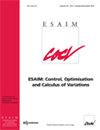A linear finite-difference scheme for approximating Randers distances on Cartesian grids
IF 1.2
3区 数学
Q4 AUTOMATION & CONTROL SYSTEMS
Esaim-Control Optimisation and Calculus of Variations
Pub Date : 2022-06-02
DOI:10.1051/cocv/2022043
引用次数: 4
Abstract
Randers distances are an asymmetric generalization of Riemannian distances, and arise in optimal control problems subject to a drift term, among other applications. We show that Randers eikonal equation can be approximated by a logarithmic transformation of an anisotropic second order linear equation, generalizing Varadhan's formula for Riemannian manifolds. Based on this observation, we establish the convergence of a numerical method for computing Randers distances, from point sources or from a domain's boundary, on Cartesian grids of dimension two and three, which is consistent at order two thirds, and uses tools from low-dimensional algorithmic geometry for best efficiency. We also propose a numerical method for optimal transport problems whose cost is a Randers distance, exploiting the linear structure of our discretization and generalizing previous works in the Riemannian case. Numerical experiments illustrate our results.笛卡尔网格上近似兰德斯距离的线性有限差分格式
兰德斯距离是黎曼距离的非对称泛化,出现在漂移项的最优控制问题中,以及其他应用。我们证明了Randers方程可以用各向异性二阶线性方程的对数变换来近似,推广了Varadhan的黎曼流形公式。基于这一观察,我们建立了一种计算兰德斯距离的数值方法的收敛性,从点源或从域的边界,在二维和三维的笛卡尔网格上,它在三分之二阶上是一致的,并使用低维算法几何的工具来获得最佳效率。我们还利用离散化的线性结构,推广了黎曼情况下以前的工作,提出了一种以兰德斯距离为代价的最优运输问题的数值方法。数值实验验证了我们的结果。
本文章由计算机程序翻译,如有差异,请以英文原文为准。
求助全文
约1分钟内获得全文
求助全文
来源期刊

Esaim-Control Optimisation and Calculus of Variations
Mathematics-Computational Mathematics
自引率
7.10%
发文量
77
期刊介绍:
ESAIM: COCV strives to publish rapidly and efficiently papers and surveys in the areas of Control, Optimisation and Calculus of Variations.
Articles may be theoretical, computational, or both, and they will cover contemporary subjects with impact in forefront technology, biosciences, materials science, computer vision, continuum physics, decision sciences and other allied disciplines.
Targeted topics include:
in control: modeling, controllability, optimal control, stabilization, control design, hybrid control, robustness analysis, numerical and computational methods for control, stochastic or deterministic, continuous or discrete control systems, finite-dimensional or infinite-dimensional control systems, geometric control, quantum control, game theory;
in optimisation: mathematical programming, large scale systems, stochastic optimisation, combinatorial optimisation, shape optimisation, convex or nonsmooth optimisation, inverse problems, interior point methods, duality methods, numerical methods, convergence and complexity, global optimisation, optimisation and dynamical systems, optimal transport, machine learning, image or signal analysis;
in calculus of variations: variational methods for differential equations and Hamiltonian systems, variational inequalities; semicontinuity and convergence, existence and regularity of minimizers and critical points of functionals, relaxation; geometric problems and the use and development of geometric measure theory tools; problems involving randomness; viscosity solutions; numerical methods; homogenization, multiscale and singular perturbation problems.
 求助内容:
求助内容: 应助结果提醒方式:
应助结果提醒方式:


